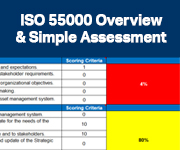Why Your Facility Needs an Asset Management Strategy
By Rick Wheeler, Life Cycle Engineering
Asset-intensive organizations like manufacturing plants, industrial facilities and public utilities depend on excellent management of physical assets to reliably meet operational and financial goals. Many owners confuse a capital asset replacement plan (a reactive and costly strategy) with an asset management strategy that proactively reduces cost and risks while extending and maximizing the useful life of the assets.
Many organizations struggle to establish a consistent, long-term strategy for managing their assets. While ISO certification is certainly not required to have a best-in-class strategy, the ISO 55000 Standard for Asset Management provides guidance for organizations that want to establish an asset management system to optimize cost, risk and performance across the life cycle of their assets.
Why is an asset management system so important? It defines how assets will be managed, across their life cycle, to meet what ISO calls stakeholder requirements – the requirements of customers, employees, suppliers, communities and shareholders.
There’s a myth that implementing a computerized Enterprise Asset Management System will create an asset management system, but that’s just not true. While software can – and must – support your asset management system it doesn’t create the system for you.
As defined by ISO 55000 an asset management system consists of four components: a policy, objectives, a strategic asset management plan, and asset management plans. It’s the asset management plans that really determine how assets will be managed and operated, at an agreed-upon service level, while optimizing total cost of ownership, at an appropriate level of risk.
Why is it so challenging to develop an asset management strategy and system that will produce sustainable results? There are two particularly difficult areas:
- Preparing an organization to embrace the principles by which the organization intends to apply asset management. This requires organizational change management that ensures executive sponsorship and integrates the technical and people sides of change.
- Developing the processes, procedures and knowledge that, when applied effectively across all stages of the asset life cycle, will provide the optimal return on investment. This requires a properly trained workforce equipped with the right resources.
Has your organization’s leadership embraced the need for an asset management system that balances cost, performance and risk, and operates to the benefit of all stakeholders? It’s worth considering the long-term benefits.
Rick Wheeler is the Executive Director of Asset Management Services at Life Cycle Engineering (LCE). He is responsible for deploying new products and services to support asset management systems based on the ISO 55000 body of knowledge. Rick is a member of USTAG 251, which is responsible for the update and improvement of the ISO 55000 standards and of the GFMAM P-20 work team updating the Maintenance Framework document. You can reach Rick at rwheeler@LCE.com.

